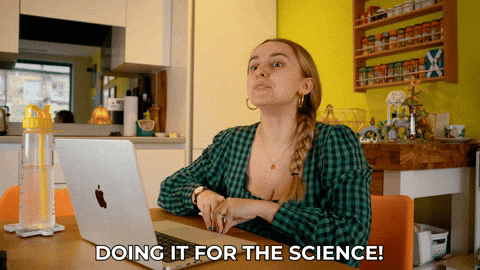
Published on Jan 29, 2024
Last modified on Apr 14, 2025
Is HIIT *Actually* Good For Menopause?
4 min read
For many women in the menopause transition, weight changes can come as a surprise, especially if you haven’t changed any of your habits. And don’t even get us started on “menopause belly”…
While diet makes the biggest difference, exercise is important too. But here’s the thing: just because an exercise routine may have been effective in our 20s or 30s doesn’t mean it’s going to impact our bodies in the same way now.
High intensity interval training — or HIIT for short — is the perfect example. Below, we’re breaking down what we know about how HIIT impacts our bodies, if it’s as effective as people make it out to be, and whether it’s actually the type of exercise we should be prioritizing during these years.
What is HIIT?
As the name suggests, HIIT is an exercise practice where you alternate between short but INTENSE periods of exercise with quick recovery periods in between.
Examples of high-intensity exercises include:
- Cardio: hill, rower, cycling sprints
- Weight-bearing: kettlebell swings, clean & press, squat thrusters
- Bodyweight: push-ups, burpees, mountain climbers, high knees, jumping jacks
Is HIIT good for menopausal women?
There’s no shortage of studies on high-intensity exercise showing that it can help burn calories, shed belly fat for improved body composition, gain muscle…PLUS it can do it all in a shorter amount of time.
So it’d be safe to assume that menopausal women have a green light to go all-in on HIIT, right?
Not exactly.
Very few studies on HIIT have been conducted exclusively on women, and even fewer on women in perimenopause/menopause. The research we do have on this population shows conflicting results. Take this meta-analysis from 2020, for example. It examined the efficacy of HIIT on weight loss, total fat mass, and abdominal fat mass in both normal-weight and overweight women before AND after menopause. Results showed that effects were more evident in pre-menopausal women than postmenopausal, leading researchers to conclude that “further studies are still needed to draw meaningful conclusions about the real effectiveness of HIIT protocols in postmenopausal women.”
There are a few potential reasons why HIIT doesn’t “hit” the same once we get older.
📉 Hormonal changes impact the way our body responds to exercise
While short cardio pushes are great for blood sugar regulation, cognition, memory…you name it, we want to avoid a long, sustained, high-impact workout since that spikes cortisol (which is already high during menopause). When this stress hormone is triggered over and over and over again, it can signal to the body that it should hold onto fat tissue, which is precisely what we DON’T want.
💤 Lack of sleep also impacts the effect of exercise in a BIG way
Many, many women have trouble falling and staying asleep during these years — it’s one of the more common menopause symptoms that also has a downstream effect on other symptoms like libido, weight, and anxiety.
When we don’t get a good night’s sleep, cortisol increases. And when cortisol increases, it messes with melatonin (the natural hormone our bodies use to regulate the circadian sleep-wake cycle) and insulin (aka blood sugar). Together, these hormonal fluctuations interfere with the body’s fat-burning mechanisms and prevent the muscles we just worked so hard on from recovering as they should.
READ MORE:
- Elektra’s Full Guide To Sleep Problems During Menopause
- Trouble Sleeping During Menopause? These Natural Sleep Aids May Help.
🦴 Don’t forget about joint and muscle aches, too
Both joint aches (arthralgia) and muscle aches (myalgia) become more common with age and the onset of menopause, and high-impact physical activity doesn’t help. Instead, it’s best to keep it low impact with swimming, yoga, and barre.
READ MORE: Elektra’s Full Guide To Joint & Muscle Aches
The bottom line
Just because HIIT may have helped with body fat loss earlier in your life doesn’t necessarily mean it’ll have the same impact now. But that doesn’t necessarily mean we have to avoid it forever. If you DO decide to give HIIT workouts a whirl, be sure to focus on short intervals that don’t extend past 60 seconds (30 seconds is the sweet spot). And don’t forget to warm up first!
And remember, it’s not HIIT or nothing. There are several types of low and moderate-intensity exercises that can help with muscle mass, weight management, cardiovascular health, and improved bone density all while keeping our cortisol levels and blood sugar levels stable. Here’s what we recommend:
- Strength/resistance training
Strength training exercises use weight (your body, hand weights, etc.) or resistance (resistance bands, etc.) to build muscle mass and help reduce the risk of osteoporosis. - Yoga
Yoga is a powerful mind-body practice. It’s equipment-free (besides the mat, of course) and uses your body as the weight to help work on flexibility and balance — all things that become increasingly important as we age. - Walking
While we want to avoid high-intensity cardio for prolonged periods of time, walking is still VERY encouraged. In fact, a recently-released study on the association between daily step count and mortality found that, for every increase of 1,000 steps per day, there was a 15% decrease in all-cause mortality, and for an increase of 500 steps per day, there was a 7% decrease in cardiovascular mortality (i.e. heart disease). Walking may also have an effect on symptoms of depression among menopausal women.
READ MORE: 3 Exercises For Menopause To Try This Year



